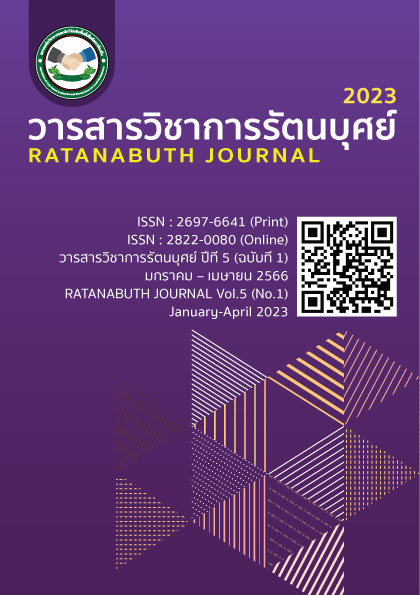System of Positions and Government Compensation System of Positions and Government Compensation
Main Article Content
Abstract
This academic article aims to study about the classification system and government compensation. and suggest guidelines on the classification system and government compensation. Thailand has adopted a position classification system based on the nature of responsibilities in personnel management. For the first time in the Thai civil service in 1975, instead of the Rank Classification system, later in the year 1992, the Civil Service Act B.E. and revised some important parts to be more suitable from the improvement of the new position classification system and compensation benefits to both the people. government sector or government and civil servants 1) People 2) Public sector or government and 3) Government officials. The development of the country or organization is therefore important. and the necessity of relying on personnel who are important mechanisms of propulsion Therefore, human resource management The classification system and government compensation are therefore important in order for personnel to match the job and build morale. The author uses the concept of the Michigan Model of HRM to be used in the analysis of human resource management. 1) Analyte and design on the Job. 2) Personnel planning, 3) Personnel recruitment and selection, 4) Personnel performance appraisal.5) Compensation management, and 6) Progress management. To present the concept of human resource management, especially the classification system and government compensation. In order to achieve the greatest benefit in the administration of the public sector is important.
Article Details

This work is licensed under a Creative Commons Attribution-NonCommercial-NoDerivatives 4.0 International License.
References
กาญจนา เฉลิมพงษ์ และคณะ. ( ม.ม.ป.). ระบบจำแนกตำแหน่งและค่าตอบแทนใหม่. (ม.ม.พ.).
เกริกยศ ชลายนเดชะ. (2549). การนำกลยุทธ์ไปสู่การปฏิบัติ. การวางแผนกลยุทธ์และการพัฒนาคุณภาพบริการของโรงพยาบาล (หน่วยที่ 9 น. 1-76). นนทบุรี: สำนักพิมพ์แห่งมหาวิทยาลัยสุโขทัยธรรมาธิราช.
กัลยาณีเสนาสุ. (2560). การบริหารค่าตอบแทนเชิงกลยุทธ์. พิมพ์ครั้งที่ 3. กรุงเทพฯ: สำนักพิมพ์สถาบันบัณฑิตพัฒนบริหารศาสตร์.
จตุรงค์ ศรีวงษวรรณะ. (2558). การบริหารทรัพยากรมนุษย์. กรุงเทพฯ: โอเดียนสโตร์.
คํานาย อภิปรัชญาสกุล. (2557). การบริหารทรัพยากรบุคคล (Human Resource Management). กรุงเทพฯ: โฟกัสมีเดีย แอนด์พับลิชซิ่ง.
นิทัศน์ ศิริโชติรัตน์. (2559). หลักการบริหารทรัพยากรมนุษย์ในศตวรรษที่ 21. พิมพ์ครั้งที่ 2. กรุงเทพฯ: สํานักพิมพ์แห่งจุฬาลงกรณ์มหาวิทยาลัย.
เดชา เดชะวัฒนไพศาล.(2559).การจัดการทรัพยกรบุคคล พื้นฐานแนวคิดเพื่อการปฏิบัติ. กรุงเทพฯ: สำนักพิมพ์แห่งจุฬาลงกรณ์มหาวิทยาลัย.
ดาวิษา ศรีธัญรัตน์.(2562). ระบบงานทรัพยากรมนุษย์เชิงกลยุทธ์เพื่อการพัฒนาองค์การ. กรุงเทพฯ: สํานักพิมพ์สถาบัน บัณฑิตพัฒนบริหารศาสตร์.
ธงชัย สันติวงษ์. (2543). กลยุทธ์และนโยบายธุรกิจ. กรุงเทพฯ: ไทยวัฒนาพานิช.
ทิพวรรณ หล่อสุวรรณรัตน์. (2562). องค์การแห่งความรู้จากแนวคิดสู่การปฏิบัติ. กรุงเทพฯ: แซทโฟร์ พริ้นติ้ง.
พงศ์นที คงถาวร, ผัสสพรรณ ถนอมพงษ์ชาติ และจุไรรัตน์ สุดรุ่ง.(2564). แนวทางการจัดการและพัฒนาบุคลากรสายสนับสนุนการศึกษาเพื่อส่งเสริมประสิทธิภาพ การสอนของครูในโรงเรียนมัธยมศึกษาสังกัดสำนักงานคณะกรรมการการศึกษาขั้นพื้นฐาน.วารสารศึกษาศาสตร์ มหาวิทยาลัยขอนแก่น,4(2):76-96.
ราชกิจจานุเบกษา เล่ม 92. วันที่ 6 กุมภาพันธ์ 2518: หน้า 1-78.
วรรธนศม เมฆสุวรรณ และเอกสิทธิ์ สนามทอง.(2564). รูปแบบการพัฒนาองค์กรเชิงกลยุทธ์เพื่อการเปลี่ยนแปลงสำหรับองค์กรธุรกิจเอกชนในประเทศไทย. วารสารสังคมศาสตร์และมานุษยวิทยาเชิงพุทธ.6(4).
ศักดิพันธ์ ตันวิมลรัตน์. (2557). การบริหารทรัพยากรมนุษย์ทางการศึกษา แนวคิด ทฤษฎีและบทบัญญัติทางกฎหมายที่เกี่ยวข้อง. วารสารวิชาการ Veridian E-Journal. 7(3).
ศิริวรรณ เสรีรัตน์ และคณะ (2545). การจัดการและพฤติกรรมองค์การ. กรุงเทพฯ. ไดมอนด์ อิน บิส ซิเนสเวิลด์.
ศิริวรรณ เสรีรัตน์, สมชาย หิรัญกิตติ และธนวรรช ตั้งสินทรัพย์ศิริ.(2550). การจัดการและพฤติกรรมองค์การ. กรุงเทพฯ: ไดมอนด์ อิน บิสซิเนสเวิลด์.
ศิวลีย์ สิริโรจน์บริรักษ์. (2556). ระบบการจำแนกตำแหน่งและค่าตอบแทนในการบริหารทรัพยากรบุคคลแนวใหม่ (Multi Classification Scheme) กับแรงจูงใจในการปฏิบัติงาน. วารสารวิทยบริการ.28(1),123-143.
สุชาติ ณ หนองคาย. (2558). เครื่องมือในการจัดการเชิงกลยุทธ์ในการพัฒนาสุขภาพ. ในเอกสารการสอนชุดวิชาการจัดการเชิงกลยุทธ์ในการพัฒนาสุขภาพ (หน่วยที่ 7, น. 1-35). นนทบุรี: สำนักพิมพ์แห่งมหาวิทยาวิทยาลับสุโขทัยธรรมาธิราช.
สำนักงานคณะกรรมการข้าราชการพลเรือน. (2552). รายงานการวจิยเรื่องระเบียบข้าราชการในอนาคต: ระบบบริหารทรัพยากรบุคคลที่รองรับคุณลักษณะของข้าราชการในทศวรรษหน้า. นนทบุรี.
Arthur, D. (2015). Fundamentals of Human Resources Management: A Practical Guide for Today’s HR Professional (5 ed.). AMA Self-Study.
Chester, I. Barnard. (1970). The Function of Executive. Cambridge, Massachusetts: Harvard University.
Herbert, Hicks G. (1972). The Management of Organization: A Systems and Human Resources Approach. 12nd ed. New York. : Appletion-Century-Crofts.
Herbert G. Hicks, 1977). The Management of Organization: A Systems and Human Resources Approach. New York: McGraw-Hill.
Joseph M. P. (2015). Human Resource Management: A Dynamic Approach. Laxmi Publications Pvt Ltd.
Ntabeni-Bhebe, F. (2019). Global Human Resources Management. Society Publishing.


